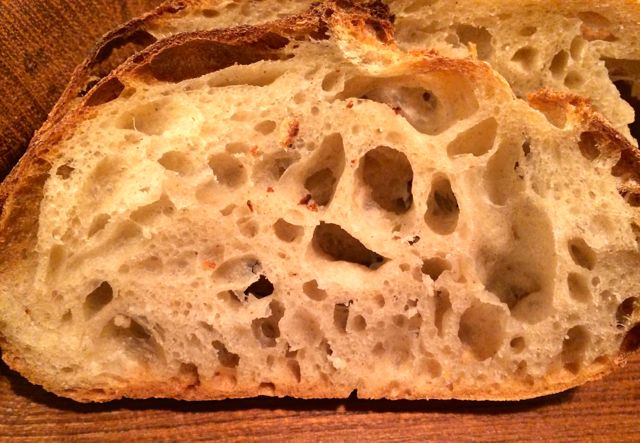Blog posts
Tartine Bread Baguettes and another learning attempt at some jalepeno bread

I made my first baguettes this weekend. It was pretty fun! Especially since I got to use my new couche and peel for the first time. Thanks to all who gave me advice on my questions about getting enough steam - the cloth method worked great!

I feel like there wasn't as many air pockets as I thought there would be in the crumb.. So maybe they were slightly under proofed?

- Log in or register to post comments
- 2 comments
- View post
- portermariena's Blog
Need Advice for Sticky Dough
Hi Everyone,
This is my first entry and I hope that I can find some help. I bake mostly sourdough loafs (75% hydration) with organic Bobs Red Mill flower (90% white, 10%wheat, or sometimes 10% sprouted spelt). Mostly I am very happy with the texture and taste of the bread, however I have one reoccurring problem…sometimes my bread will stick to my benneton during the final resting period. Is it a matter of not dusting the bowl with enough flower?
- Log in or register to post comments
- 15 comments
- View post
- redgebendheim's Blog
My first bake since back from Italy: San Joaquin Sourdough

This bake followed my usual formula, except I increased the hydration slightly, adding an extra 20 g of water to the final dough. The formula and procedures can be found here: San Joaquin Sourdough: Update


- Log in or register to post comments
- 9 comments
- View post
- dmsnyder's Blog
Sunflower seeded Tartine polenta bread

I was pretty happy with my first attempt at a polenta sourdough (http://www.thefreshloaf.com/node/38701/polenta-sourdough). The hydration in that first loaf was 70% without taking into account the water in the polenta porridge. But I wanted a loaf with higher hydration, a more open crumb and more polenta. I decided to go with the tried and true Tartine basic country bread.
- Log in or register to post comments
- 10 comments
- View post
- emkay's Blog
How long to bulk ferment?

Lately in the midst of making a lot of decent bread, I've had a string of mysterious failures. Here are the symptoms: at best poor opening of scores which leaves the resulting bread more compact than it should be and with gummier crumb. At worst cakey crumb and collapses along the crust which leave a skin of paperlike crust with a cavern beneath. The second gets thrown out; the first is fine to eat but nothing great.
- Log in or register to post comments
- 19 comments
- View post
- varda's Blog
Speedy Fougasse
This is a recipe I've been waiting to bake for four years, and after all that wait its definitely worth it, here is a super fast recipe - start to finish in less than two hours and a delicious loaf to enjoy
Full recipe on my blog here

- Log in or register to post comments
- View post
- HokeyPokey's Blog
Farmer's Market Week 36 (Pane Maggiore) + NY Rye

It's been a while and I had a craving for some PVM. I figured I'd do one final experiment and see the results using a stiff levain.
I've used an 18 hour liquid wheat whole wheat levain (the original), 1/2 liquid white levain, 1/2 liquid wheat levain + 1/2 white, 1/2 white levain and 1/2 rye sour. I think the best is the 1/2 liquid white 1/2 liquid wheat.
- Log in or register to post comments
- 11 comments
- View post
- Anonymous's Blog
Roasted Corn & Red Peppers Sourdough

This is a big one...and a tasty one, great with some barbeque. If you are on a diet the butter and yogurt in this one is not going to do you any favors, but both added to the overall moistness in the final dough.
I love the way the roasted red peppers compliment the corn and the combination of Semolina flour along with the other flours really gives this bread a unique flavor worth trying.
- Log in or register to post comments
- 14 comments
- View post
- Isand66's Blog
67% Whole 10 Grain Baguettes

After seeing Phyllis’s fine baguettes based on David Snyder’s San Joaquin recipe this week, we decided that we would do some baguettes to practice slashing - it’s been at least a year. Plus the he date of Lucy’s Mom’s untimely death is approaching and that requires some kind slashing, no matter what, in her honor – lighting a candle just won’t do.
- Log in or register to post comments
- 24 comments
- View post
- dabrownman's Blog



